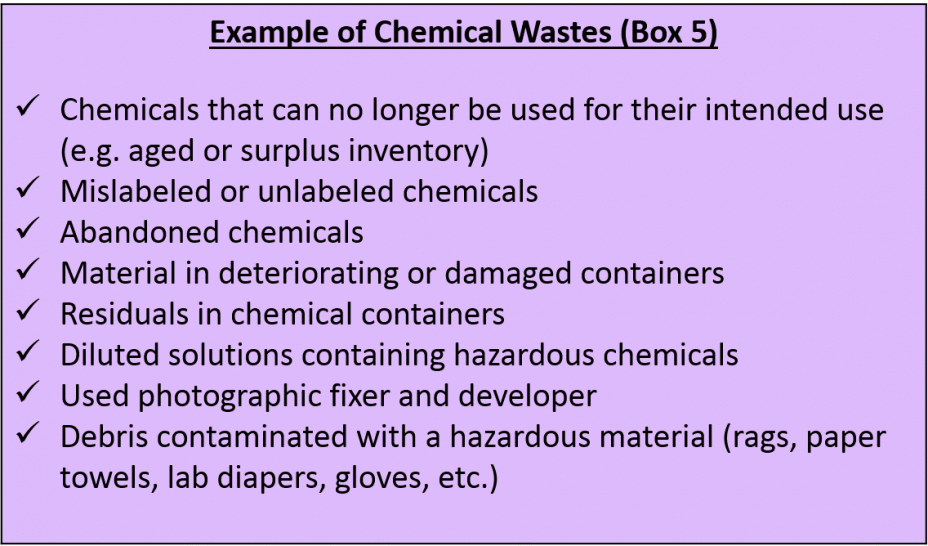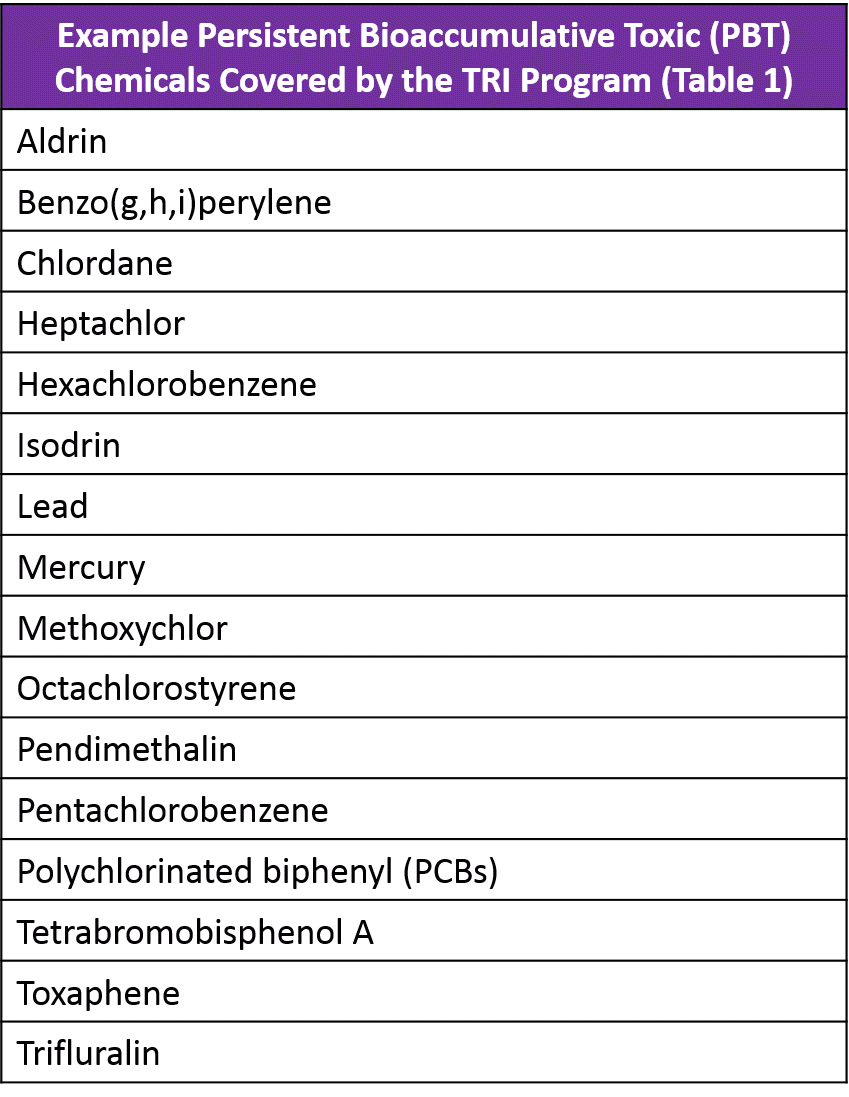Lean & Chemicals Toolkit: Chapter 2
Chemicals Overview
- Definition of Chemical Waste
- Understanding the Dangers of Chemicals
- Examples of Hazardous Chemicals
- How to Learn More about Chemicals
- The Chemical Lifecycle
- To Consider
- Toolkit Navigation
Definition of Chemical Waste
![]() As discussed in Chapter 1, chemical waste is any unnecessary or excess use of a chemical, or a chemical substance that could harm human health or the environment when released to the air, water, or land. Chemical waste is a subset of “environmental waste” described in EPA’s Lean and Environment Toolkit.
As discussed in Chapter 1, chemical waste is any unnecessary or excess use of a chemical, or a chemical substance that could harm human health or the environment when released to the air, water, or land. Chemical waste is a subset of “environmental waste” described in EPA’s Lean and Environment Toolkit.
Many chemical wastes can be classified as hazardous waste. Hazardous wastes are the types of waste that can cause the most damage to human health and the environment. Hazardous wastes can be liquids, solids, gases, or sludge. They can be discarded commercial products, such as cleaning fluids or pesticides, or the by-products of manufacturing processes.
Box 5 lists examples of chemical wastes. While containers used to store hazardous waste have easy-to-spot indicators of chemical waste, other sources may be more difficult to identify, including chemical waste that may be hidden in established processes. Other chemical wastes include excess mixed or unmixed chemicals and materials contaminated with chemicals.
Understanding the Dangers of Chemicals
Many types of chemicals are hazardous. For safety and security it is important to be able to recognize any dangers involved in storing and using certain chemicals. It is also important to know about chemical characteristics when disposing of chemicals to ensure that those wastes are disposed of properly. Hazardous chemical warning signs exist to warn people of the dangers involved in using certain chemicals. Figure 1 describes several common chemical warning signs.
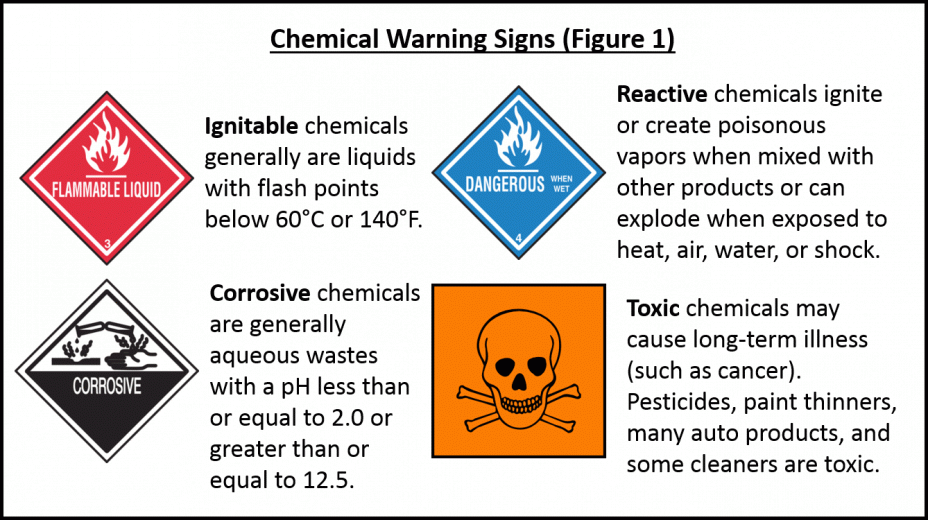 Another common system for identifying chemical hazards is the U.S. National Fire Protection Association (NFPA) system. NFPA chemical hazard warning labels are attached to the containers with the chemicals. Although it looks simple, an NFPA label carries a lot of important information about a chemical. NFPA labels are color coded; each color on the label represents a different type of hazard. The system also uses a numerical rating system. Zero represents little to no danger, while a rating of four represents the greatest danger.
Another common system for identifying chemical hazards is the U.S. National Fire Protection Association (NFPA) system. NFPA chemical hazard warning labels are attached to the containers with the chemicals. Although it looks simple, an NFPA label carries a lot of important information about a chemical. NFPA labels are color coded; each color on the label represents a different type of hazard. The system also uses a numerical rating system. Zero represents little to no danger, while a rating of four represents the greatest danger.
Figure 2 contains an example of a label from the NFPA system for the chemical diborane. According to the rating system, diborane is extremely flammable, reactive, and presents a serious health hazard.
Examples of Hazardous Chemicals
For the most up-to-date list of hazardous and toxic chemicals, visit the Toxics Release Inventory (TRI). TRI tracks the management of certain toxic chemicals that may pose a threat to human health and the environment. U.S. facilities in different industry sectors must report annually how much of each chemical is released to the environment and/or managed through recycling, energy recovery and treatment. (A "release" of a chemical means that it is emitted to the air or water, or placed in some type of land disposal.) Table 1 offers an example of chemicals listed as persistent bioaccumulators. Note that these are only 16 of the total list of 390 chemicals and chemical categories.
How to Learn More about Chemicals
Understanding the types of chemicals your business uses and the hazards associated with them is the first step to take when deciding how and where to eliminate chemical wastes. There are a variety of resources available for learning more about chemicals and their characteristics. Two important resources include Material Safety Data Sheets and a Pocket Guide to Chemical Hazards.
![]() Material Safety Data Sheets (MSDS) are an important resource and safety tool for workers who handle chemicals. MSDSs are designed to provide both workers and emergency personnel with the proper procedures for handling or working with a particular substance. The Occupational Health and Safety Administration (OSHA) requires that MSDS forms be available to all employees working with chemicals. MSDSs include information on physical data (melting point, boiling point, flash point, etc.), toxicity, health effects, first aid, reactivity, storage, disposal, protective equipment, and spill/leak procedures. These are of particular use if a spill or accident occurs. Appendix B contains a template for a Material Safety Data Sheet.
Material Safety Data Sheets (MSDS) are an important resource and safety tool for workers who handle chemicals. MSDSs are designed to provide both workers and emergency personnel with the proper procedures for handling or working with a particular substance. The Occupational Health and Safety Administration (OSHA) requires that MSDS forms be available to all employees working with chemicals. MSDSs include information on physical data (melting point, boiling point, flash point, etc.), toxicity, health effects, first aid, reactivity, storage, disposal, protective equipment, and spill/leak procedures. These are of particular use if a spill or accident occurs. Appendix B contains a template for a Material Safety Data Sheet.
Another tool for identifying and understanding hazardous chemicals is a pocket guide to chemical hazards issued by the National Institute for ![]() Occupational Safety and Health (NIOSH) of the Centers for Disease Control and Prevention (CDC). The NIOSH Pocket Guide to Chemical Hazards (NPG) is a source of general industrial hygiene information on several hundred chemicals for workers, employers, and occupational health professionals. The NPG does not contain an analysis of all pertinent data; instead it presents key information and data in abbreviated or tabular form for chemicals or substance groupings (e.g., cyanides, fluorides, manganese compounds) that are found in the work environment. The pocket guide includes the following information:
Occupational Safety and Health (NIOSH) of the Centers for Disease Control and Prevention (CDC). The NIOSH Pocket Guide to Chemical Hazards (NPG) is a source of general industrial hygiene information on several hundred chemicals for workers, employers, and occupational health professionals. The NPG does not contain an analysis of all pertinent data; instead it presents key information and data in abbreviated or tabular form for chemicals or substance groupings (e.g., cyanides, fluorides, manganese compounds) that are found in the work environment. The pocket guide includes the following information:
- NIOSH Recommended Exposure Limits
- Occupational Safety and Health Administration (OSHA) Permissible Exposure Limits
- A physical description of the agent with chemical and physical properties
- Measurement methods
- Personal protection and sanitation recommendations
- Respirator recommendations
- Information on health hazards including route, symptoms, first aid, and target organ information
Appendix A describes additional chemical resources, including resources for identifying substitutes for hazardous chemicals. Furthermore, Chapter 6 (Lean Product and Process Design Methods) describes strategies and tools for designing products and processes that use less hazardous chemicals.
The Chemical Lifecycle
![]() The use of chemicals for production is just one part of the “lifecycle” of a chemical. The chemical lifecycle includes all the activities involved in the manufacturing, use, storage, disposal, and possible re-use of chemical substances. Figure 3 outlines the stages of the chemical lifecycle.
The use of chemicals for production is just one part of the “lifecycle” of a chemical. The chemical lifecycle includes all the activities involved in the manufacturing, use, storage, disposal, and possible re-use of chemical substances. Figure 3 outlines the stages of the chemical lifecycle.
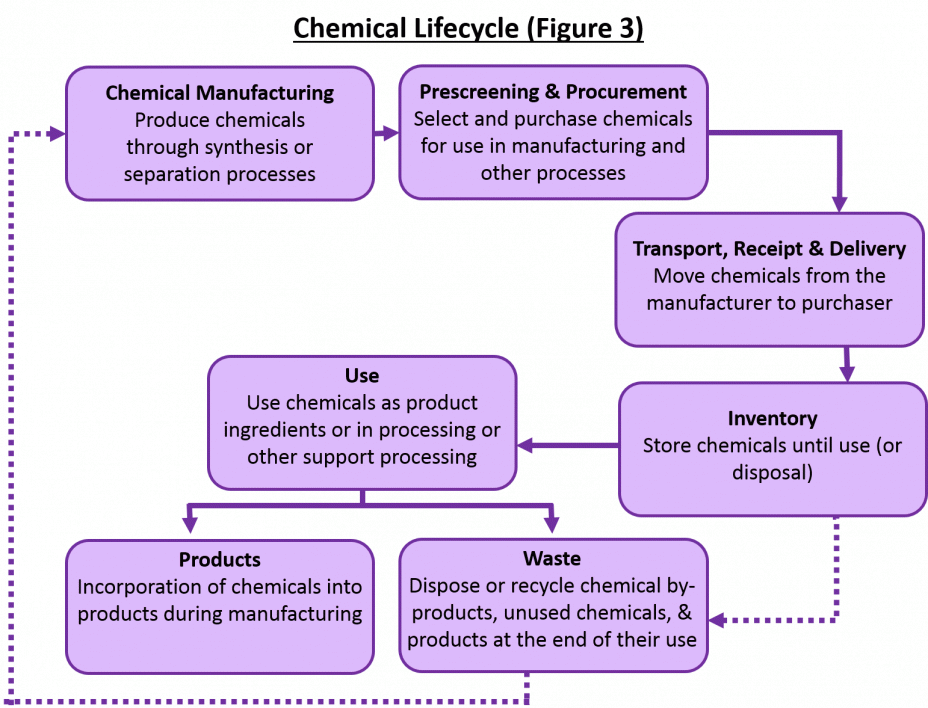 As with typical product “value streams” (which generally focus on the “use” or “manufacturing” steps), there are non-value added activities (wastes) associated with each step in the chemical lifecycle. The following chapters in this toolkit describe a variety of ways that Lean methods can be used to identify and reduce chemical wastes. Chapters 3, 4, and 5 focus on reducing wastes in the “inventory,” “use,” and “waste” stages of the chemical lifecycle. Chapter 6, with its focus on product design, covers strategies that affect multiple stages in the lifecycle, including chemical manufacturing and the selection of chemicals.
As with typical product “value streams” (which generally focus on the “use” or “manufacturing” steps), there are non-value added activities (wastes) associated with each step in the chemical lifecycle. The following chapters in this toolkit describe a variety of ways that Lean methods can be used to identify and reduce chemical wastes. Chapters 3, 4, and 5 focus on reducing wastes in the “inventory,” “use,” and “waste” stages of the chemical lifecycle. Chapter 6, with its focus on product design, covers strategies that affect multiple stages in the lifecycle, including chemical manufacturing and the selection of chemicals.
Toolkit Navigation
- Contents & Acknowledgements
- Executive Summary
- Preface
- Chapter 1: Introduction
- Chapter 2: Chemicals Overview
- Chapter 3: Driving Out Chemical Waste with Lean Events
- Chapter 4: Chemical Management in the Lean Organization
- Chapter 5: Managing Chemicals in Lean Workspaces
- Chapter 6: Lean Product and Process Design Methods
- Chapter 7: Conclusion
- Appendix A: Chemical Resources
- Appendix B: Material Safety Data Sheet Template Example
- Appendix C: Point-of-Use Storage Request Form Example

